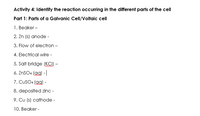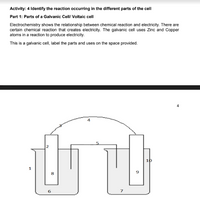
Chemistry: Matter and Change
1st Edition
ISBN: 9780078746376
Author: Dinah Zike, Laurel Dingrando, Nicholas Hainen, Cheryl Wistrom
Publisher: Glencoe/McGraw-Hill School Pub Co
expand_more
expand_more
format_list_bulleted
Question
What are the uses of the parts

Transcribed Image Text:Activity 4: Identify the reaction occurring in the different parts of the cell
Part 1: Parts of a Galvanic Cell/Voltaic cell
1. Beaker -
2. Zn (s) anode -
3. Flow of electron -
4. Electrical wire -
5. Salt bridge (KCI) –
6. ZNSO4 (ag) -
7. CUSO4 (ag) -
8. deposited zinc -
9. Cu (s) cathode -
10. Beaker -

Transcribed Image Text:Activity: 4 Identify the reaction occurring in the different parts of the cell
Part 1: Parts of a Galvanic Cell/ Voltaic cell
Electrochemistry shows the relationship between chemical reaction and electricity. There are
certain chemical reaction that creates electricity. The galvanic cell uses Zinc and Copper
atoms in a reaction to produce electricity.
This is a galvanic cell, label the parts and uses on the space provided.
4
10
1
7
Expert Solution
This question has been solved!
Explore an expertly crafted, step-by-step solution for a thorough understanding of key concepts.
This is a popular solution
Trending nowThis is a popular solution!
Step by stepSolved in 3 steps with 3 images

Knowledge Booster
Learn more about
Need a deep-dive on the concept behind this application? Look no further. Learn more about this topic, chemistry and related others by exploring similar questions and additional content below.Similar questions
- For a voltage-sensitive application, you are working on a battery that must have a working voltage of 0.85 V. The half-cells to be used have a standard cell potential of 0.97 V. What must be done to achieve the correct voltage? What information would you need to look up?arrow_forwardThe following two half-reactions arc involved in a voltaic cell. At standard conditions, what species is produced at each electrode? Ag++eAgE=0.80VNi2++2eNiE=0.25Varrow_forwardThe mass of three different metal electrodes, each from a different galvanic cell, were determined before and after the current generated by the oxidation-reduction reaction in each cell was allowed to flow for a few minutes. The first metal electrode, given the label A, was found to have increased in mass; the second metal electrode, given the label B, did not change in mass; and the third metal electrode, given the label C, was found to have lost mass. Make an educated guess as to which electrodes were active and which were inert electrodes, and which were anode(s) and which were the cathode(s).arrow_forward
- As the voltaic cell shown here runs, the blue solution gradually gets lighter in color and the gray solution gets darker. (a) What species is oxidized and what is reduced? (b) Which electrode is the anode and which is the cathode? (C) Which metal electrode gains mass? (d) In which direction do electrons flow through the external circuit?arrow_forwardAn active (metal) electrode was found to gain mass as the oxidation-reduction reaction was allowed to proceed. Was the electrode part of the anode or cathode? Explain.arrow_forwardSketch a galvanic cell, and explain how it works. Look at Figs. 18.1 and 18.5. Explain what is occurring in each container and why the cell in Fig. 18.5 “works,” but the one in Fig. 18.1 does not.arrow_forward
- Why is a salt bridge necessary in galvanic cells like the one in Figure 17.4?arrow_forwardConsider a concentration cell that has both electrodes made of some metal M. Solution A in one compartment of the cell contains 1.0 M M2+. Solution B in the other cell compartment has a volume of 1.00 L. At the beginning of the experiment 0.0100 mole of M(NO3)2 and 0.0100 mole of Na2SO4 are dissolved in solution B (ignore volume changes), where the reaction M2+(aq)+SO42(aq)MSO4(s) occurs. For this reaction equilibrium is rapidly established, whereupon the cell potential is found to be 0.44 V at 25C. Assume that the process M2++2eM has a standard reduction potential of 0.31 V and that no other redox process occurs in the cell. Calculate the value of Ksp for MSO4(s) at 25C.arrow_forwardConsider a galvanic cell based on the following half-reactions: a. What is the expected cell potential with all components in their standard states? b. What is the oxidizing agent in the overall cell reaction? c. What substances make up the anode compartment? d. In the standard cell, in which direction do the electrons flow? e. How many electrons are transferred per unit of cell reaction? f. If this cell is set up at 25C with [Fe2+] = 2.00 104 M and [La3+] = 3.00 103 M, what is the expected cell potential?arrow_forward
- If a logarithmic scale had not been used for the graph of Figure 13.13, what would the plots look like? FIGURE 13.13 The variation of equilibrium constant with cell potential is shown. The different lines correspond to reactions involving the transfer of one, two, or three electrons, as indicated.arrow_forwardUse the data from the table of standard reduction potentials in Appendix H to calculate the standard potential of the cell based on each of the following reactions. In each case, state whether the reaction proceeds spontaneously as written or spontaneously in the reverse direction under standard-state conditions. (a) H2(g)+Cl2(g)2H+(aq)+2Cl(aq) (b) Al3+(aq)+3Cr2+(aq)Al(s)+3Cr3+(aq) (c) Fe2+(aq)+Ag+(aq)Fe3+(aq)+Ag(s)arrow_forwardComplete the following cell notation. Ag|Br(3.73M)|AgBrH+(?)|H2(1.0atm)|PtE=0.030Varrow_forward
arrow_back_ios
SEE MORE QUESTIONS
arrow_forward_ios
Recommended textbooks for you
- Chemistry: Matter and ChangeChemistryISBN:9780078746376Author:Dinah Zike, Laurel Dingrando, Nicholas Hainen, Cheryl WistromPublisher:Glencoe/McGraw-Hill School Pub Co
 Chemistry for Engineering StudentsChemistryISBN:9781337398909Author:Lawrence S. Brown, Tom HolmePublisher:Cengage Learning
Chemistry for Engineering StudentsChemistryISBN:9781337398909Author:Lawrence S. Brown, Tom HolmePublisher:Cengage Learning General Chemistry - Standalone book (MindTap Cour...ChemistryISBN:9781305580343Author:Steven D. Gammon, Ebbing, Darrell Ebbing, Steven D., Darrell; Gammon, Darrell Ebbing; Steven D. Gammon, Darrell D.; Gammon, Ebbing; Steven D. Gammon; DarrellPublisher:Cengage Learning
General Chemistry - Standalone book (MindTap Cour...ChemistryISBN:9781305580343Author:Steven D. Gammon, Ebbing, Darrell Ebbing, Steven D., Darrell; Gammon, Darrell Ebbing; Steven D. Gammon, Darrell D.; Gammon, Ebbing; Steven D. Gammon; DarrellPublisher:Cengage Learning  Chemistry for Engineering StudentsChemistryISBN:9781285199023Author:Lawrence S. Brown, Tom HolmePublisher:Cengage Learning
Chemistry for Engineering StudentsChemistryISBN:9781285199023Author:Lawrence S. Brown, Tom HolmePublisher:Cengage Learning World of Chemistry, 3rd editionChemistryISBN:9781133109655Author:Steven S. Zumdahl, Susan L. Zumdahl, Donald J. DeCostePublisher:Brooks / Cole / Cengage Learning
World of Chemistry, 3rd editionChemistryISBN:9781133109655Author:Steven S. Zumdahl, Susan L. Zumdahl, Donald J. DeCostePublisher:Brooks / Cole / Cengage Learning Introductory Chemistry: A FoundationChemistryISBN:9781337399425Author:Steven S. Zumdahl, Donald J. DeCostePublisher:Cengage Learning
Introductory Chemistry: A FoundationChemistryISBN:9781337399425Author:Steven S. Zumdahl, Donald J. DeCostePublisher:Cengage Learning

Chemistry: Matter and Change
Chemistry
ISBN:9780078746376
Author:Dinah Zike, Laurel Dingrando, Nicholas Hainen, Cheryl Wistrom
Publisher:Glencoe/McGraw-Hill School Pub Co

Chemistry for Engineering Students
Chemistry
ISBN:9781337398909
Author:Lawrence S. Brown, Tom Holme
Publisher:Cengage Learning

General Chemistry - Standalone book (MindTap Cour...
Chemistry
ISBN:9781305580343
Author:Steven D. Gammon, Ebbing, Darrell Ebbing, Steven D., Darrell; Gammon, Darrell Ebbing; Steven D. Gammon, Darrell D.; Gammon, Ebbing; Steven D. Gammon; Darrell
Publisher:Cengage Learning

Chemistry for Engineering Students
Chemistry
ISBN:9781285199023
Author:Lawrence S. Brown, Tom Holme
Publisher:Cengage Learning

World of Chemistry, 3rd edition
Chemistry
ISBN:9781133109655
Author:Steven S. Zumdahl, Susan L. Zumdahl, Donald J. DeCoste
Publisher:Brooks / Cole / Cengage Learning

Introductory Chemistry: A Foundation
Chemistry
ISBN:9781337399425
Author:Steven S. Zumdahl, Donald J. DeCoste
Publisher:Cengage Learning